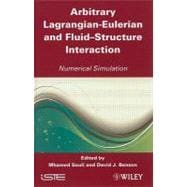
Note: Supplemental materials are not guaranteed with Rental or Used book purchases.
Purchase Benefits
Looking to rent a book? Rent Arbitrary Lagrangian Eulerian and Fluid-Structure Interaction Numerical Simulation [ISBN: 9781848211315] for the semester, quarter, and short term or search our site for other textbooks by Souli, M'hamed; Benson, David J.. Renting a textbook can save you up to 90% from the cost of buying.
Mhamed Souli is Professor of computational mechanics at Lille University in France. His research and development interests include fluid structure interaction, CFD with emphasis on multiphase flow and coupling with structures, and their applications to industrial problems.
David J. Benson is Professor of Computational Mechanics in the Department of Structural Engineering at the University of California, San Diego. He is a Fellow of the American Physical Society, American Society of Mechanical Engineers, and the US Association of Computational Mechanics. He serves on the editorial board of the International Journal of Solids and Structures.
Introduction xi
Mhamed SOULI
Chapter 1. Introduction to Arbitrary Lagrangian–Eulerian in Finite Element Methods 1
David J. BENSON
1.1. Introduction 1
1.2. Governing equations 3
1.3. Operator splitting 4
1.4. The Lagrangian step 7
1.5. Mesh relaxation 25
1.6. The Eulerian step 27
1.7. Future research directions 44
1.8. Bibliography 45
Application to Dynamic Problems 51
Mhamed SOULI
2.1. Introduction 51
2.2. General ALE description of Navier–Stokes equations 54
2.3. Fluid–structure interaction 57
2.4. Numerical applications 72
Chapter 2. Fluid–Structure Interaction: Application to Dynamic Problems 51
Mhamed SOULI
2.5. Conclusion 104
2.6. Acknowledgments 104
2.7. Bibliography 105
Chapter 3. Implicit Partitioned Coupling in Fluid–Structure Interaction 109
Michael SCHÄFER
3.1. Introduction 109
3.2. Computational fluid mechanics 110
3.3. Computational structural mechanics 121
3.4. Fluid–structure interaction algorithms 136
3.5. Results and applications 150
3.6. Bibliography 161
Chapter 4. Avoiding Instabilities Caused by Added Mass Effects in Fluid–Structure Interaction Problems 165
Sergio IDELSOHN, Facundo DEL PIN and Riccardo ROSSI
4.1. Introduction 165
4.2. The discretized equations to be solved in a FSI problem 169
4.3. Monolithic solution of the FSI equations by pressure segregation 174
4.4. Static condensation of the pressure 176
4.5. Evaluation of the Laplace matrix for FSI problems 187
4.6. The partitioned (or staggered) scheme 189
4.7. Numerical examples 195
4.8. Conclusions 215
4.9. Acknowledgments 216
4.10. Bibliography 216
Chapter 5. Multidomain Finite Element Computations: Application to Multiphasic Problems 221
Thierry COUPEZ, Hugues DIGONNET, Elie HACHEM, Patrice LAURE, Luisa SILVA, Rudy VALETTE
5.1. Introduction 221
5.2. Characterization of different phases 228
5.3. Stabilized finite element formulations 240
5.4. Multiphasic problems with fluid–air and fluid–fluid interface 256
5.5. Immersion of solid bodies in fluid 264
5.6. Conclusion 281
5.7. Acknowledgements 282
5.8. Bibliography 282
List of Authors 291
Index 293
The New copy of this book will include any supplemental materials advertised. Please check the title of the book to determine if it should include any access cards, study guides, lab manuals, CDs, etc.
The Used, Rental and eBook copies of this book are not guaranteed to include any supplemental materials. Typically, only the book itself is included. This is true even if the title states it includes any access cards, study guides, lab manuals, CDs, etc.